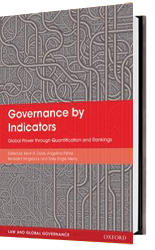Global Power through Quantification and Rankings
Kevin E. Davis, Angelina Fisher, Benedict Kingsbury & Sally Engle Merry (eds.)

The use of indicators as a technique of global governance is increasing rapidly. Major examples include the World Bank’s Doing Business Indicators, the World Bank’s Good Governance and Rule of Law indicators, the Millennium Development Goals, and the indicators produced by Transparency International. Human rights indicators are being developed in the UN and regional and advocacy organizations. The burgeoning production and use of indicators has not, however, been accompanied by systematic comparative study of, or reflection on, the implications, possibilities, and pitfalls of this practice.
This book furthers the study of these issues by examining the production and history of indicators, as well as relationships between the producers, users, subjects, and audiences of indicators. It also explores the creation, use, and effects of indicators as forms of knowledge and as mechanisms of making and implementing decisions in global governance. Using insights from case studies, empirical work, and theoretical approaches from several disciplines, the book identifies legal, policy, and normative implications of the production and use of indicators as a tool of global governance.
Table of Contents
1. Governance by Indicators, Kevin Davis, Benedict Kingsbury, and Sally Merry
2. The Dynamism Of Indicators, Wendy Nelson Espeland & Michael Sauder
3. Taming and Framing Indicators: A Legal Reconstruction of the OECD’s Programme for International Student Assessment (PISA), Armin von Bogdandy & Matthias Goldmann
4. Problems of Power in the Design of Indicators of Safety and Justice in the Global South,Christopher Stone
5. Immunization Coverage Indicators: Technology of Public Health Governance, Angelina Fisher
6. State Failure: The U.S. Fund for Peace Failed States Index, Nehal Bhuta
7. Corporations, Indicators, and Human Rights: A Material Semiotics View, Ronen Shamir & Dana Weiss
8. Trends in Mission-Driven Funding: New Impact Indicators for a New Impact Industry,Sarah Dadush
9. Legal Yardsticks: International Financial Institutions As Legal Diagnosticians And Remedial Agents, Terence C. Halliday
10. Measuring Human Rights: U.N. Indicators In Critical Perspective, AnnJanette Rosga & Margaret L. Satterthwaite
11. Internally Displaced Population in Colombia: A Case Study on the Domestic Aspects of Indicators as Technologies of Global Governance, Rene Uruena
12. The Use Of Indicators To Measure Government Responses To Human Trafficking, Anne Gallagher and Janie Chuang
13. Fighting Human Trafficking or Instituting Authoritarian Control? The Political Cooptation of Human Rights Protection in Belarus, Marina Zaloznaya & John Hagan
14. Rights-Based Humanitarian Indicators In Post-Earthquake Haiti, Margaret L. Satterthwaite
15. Accountability In The Generation Of Governance Indicators, Nikhil K. Dutta
16. Beyond Supply and Demand: A Political-Economic Conceptual Model of Measurement Standards for Global Markets, Tim Buthe
17. Public Regulation Of Global Indicators, Sabino Cassese and Lorenzo Casini





